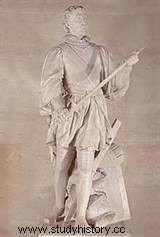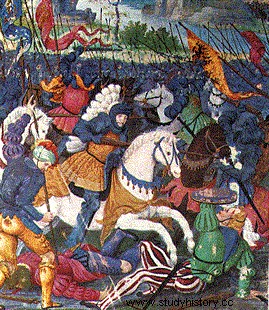 Pierre Terrail , Lord of Bayard , nicknamed "the knight without fear and without reproach", became famous for his bravery and courage during the Italian wars. He distinguished himself so brilliantly at Marignan in 1515 that François Ier wanted to be knighted by his hands after the battle. In 1522, despite prodigies of valor, he was unable to prevent the defeat of La Bicoque in Lombardy. Having received the mission to ensure the retreat of the French army after the defeat of Romagnano, he succeeded in making it pass the Sesia, but he was mortally wounded by an arquebus shot on April 30, 1524.
Pierre Terrail , Lord of Bayard , nicknamed "the knight without fear and without reproach", became famous for his bravery and courage during the Italian wars. He distinguished himself so brilliantly at Marignan in 1515 that François Ier wanted to be knighted by his hands after the battle. In 1522, despite prodigies of valor, he was unable to prevent the defeat of La Bicoque in Lombardy. Having received the mission to ensure the retreat of the French army after the defeat of Romagnano, he succeeded in making it pass the Sesia, but he was mortally wounded by an arquebus shot on April 30, 1524.
Bayard, fearless and blameless knight
Pierre Terrail, Lord of Bayard, was born in the Château de Bayard, near Grenoble, around 1475. He came from a family of knights whose ancestors were particularly famous in Poitiers or Agincourt. First a page in Chambéry with the Duke of Savoy, he began a military career in the service of King Charles VIII and accompanied him to Italy. During the Battle of Formua (1495), he distinguished himself at the head of a small troop of knights by saving the King of France in extremis. This act of bravery earned him a knighthood. From then on, his military career was nothing more than a series of legendary exploits.
Under Louis XII, he took part in the conquest of Milan and distinguished himself once again at the Garigliano bridge, in 1503. His heroic defense, alone against 200 Spaniards, to ensure the French retreat, earned him universal renown. This feat of arms, as famous as his victories in Genoa (1507), Agnadel (1509) or Brescia (1512), earned him the nickname "the knight without fear and without reproach".
In 1513 he was in Artois invaded by the English and he was taken prisoner at Guinegatte (Day of the Spurs). King Henry VIII who offers him to enter his service. Bayard's refusal:out of respect, he is released. Shortly after, he was appointed lieutenant general of Dauphiné.
Alongside Francis I in Italy
 He then participated in the military expedition of King Francis I, who crossed the Alps in the summer of 1515 and confronts the Swiss at the battle of Marignan, the following September 13 and 14. Bayard contributes decisively to this victorious battle. On the evening of the fight, triumphant, François I pays homage to French chivalry by being himself knighted by Bayard, whom he considers to be the one who seems to incarnate chivalrous values on his own, being a model of virtue, courage and of military honor. Bayard continued his military exploits by forcing the Emperor Charles V to lift the siege of Mézières in 1521.
He then participated in the military expedition of King Francis I, who crossed the Alps in the summer of 1515 and confronts the Swiss at the battle of Marignan, the following September 13 and 14. Bayard contributes decisively to this victorious battle. On the evening of the fight, triumphant, François I pays homage to French chivalry by being himself knighted by Bayard, whom he considers to be the one who seems to incarnate chivalrous values on his own, being a model of virtue, courage and of military honor. Bayard continued his military exploits by forcing the Emperor Charles V to lift the siege of Mézières in 1521.
In the spring of 1524, at the siege of Rebec, near Milan, against the Spanish army, an arquebus stone broke his spine. He is carried under a tree, facing the enemy, at his request. The constable of Bourbon, who had gone to the Spanish camp after the confiscation of part of his property by François I, came to see him and told him that he felt pity for him. Bayard gives him this answer full of ultimate panache:“Sir, there is no pity in me because I die a good man. But I pity you, to see you serve against your prince, and your country, and your oath. »
Mortally wounded, Chevalier Bayard breathed his last on the banks of the Sesia, on April 30, 1524, at the age of 49. Archetype of the Christian knight faithful to his country, he then entered the legend...
Bibliography
- Le Chevalier Bayard, by Jean-Michel Dasque. Ellipses, 2018.
- Story of Pierre Terrail, Said Le Chevalier Bayard, Without Fear And Without Reproach... by Guyard De Berville. Nabu, 2014.
